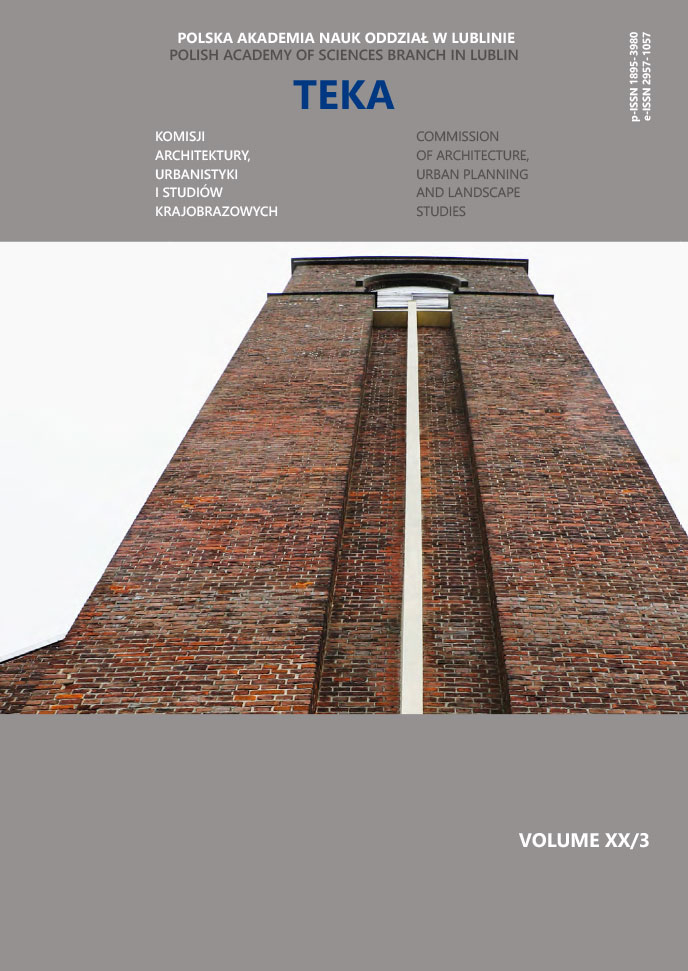Freehand drawing as a basic means of artistic expression in the process of educating future architects versus modern computer technology
Agnieszka Chęć-Małyszek
a.chec-malyszek@pollub.plDepartment of Architecture, Urban and Spatial Planning, Faculty of Civil Engineering and Architecture, Lublin University of Technology (Poland)
https://orcid.org/0000-0001-6004-0635
Abstract
Freehand drawing is one of the earliest and most important human skills. It is one of the simplest forms of recording thoughts and information from an early childhood, which allows to communicate without using words. It is the first verbal form of contact with the outside world by means of which feelings, emotions and desires are illustrated. It is something that allows one to see the surrounding beauty, see the details, learn about the structure and structure of matter and keep the image in memory for a long time. The article discusses issues related to the process of education in freehand drawing at the Faculty of , Faculty of Civil Engineering and Architecture of Lublin University of Technology. In this paper, the drawing is presented as a basic tool for presenting one's own design concept to future investors, which teaches perception, analysis, as well as develops creative and spatial imagination. Assuming that learning freehand drawing is the basis of all artistic activities, the article attempts to examine the essence of freehand drawing in the process of educating future architects at the Lublin University of Technology. The literature on the subject raises the issue of values conveyed through freehand drawing and compares it with contemporary, advanced computer programs.
Keywords:
freehand drawing, modern computer technology, means of artistic expressionReferences
Alberti L. B.,„Renesansowa teoria piękna, cz. 1” Available: https://niezlasztuka.net/o-sztuce/leon-battista-alberti-renesansowa-teoria-piekna-cz1/ [5 April 2017].
Google Scholar
Balcerzka R., M.Ozrechowski, J.Pętkowska-Henlek, M.Suffczyński, A.Sufiński, T.Trzupek, Rysunek architektoniczny w praktyce, czyli jak patrzeć ze zrozumieniem, PWN, Warsaw 2019, p.7, 170−176.
Google Scholar
Białkiewicz A., O rysunku architektonicznym, Teka Kom. Architektura i Urbanistyka Studia Krajobrazu – OL PAN, 2006,p. 53−60.
Google Scholar
Benkari N., Boudidah M., Architectural education and cultural context in the uae: challenges and opportunities, Alma Cipta Vol 7 (2), December 2014, 51−62.
Google Scholar
Gomółka J., Architectural drawing as a means of communication, „Czasopismo Techniczne. Architektura” 2015, R. 112, z. 4-A,191−194.
Google Scholar
Hansen D., “Architecture and pencil”, [w:] M.J. Żychowska [ed.], Challenges of 21st century. To draw, to paintor to use a computer, Vol. 1, Wydawnictwo PK, Cracow 2015, 48−49.
DOI: https://doi.org/10.1109/MC.2015.306
Google Scholar
Hollanda de F., Dialogi rzymskie (1548), fragment w: Disegno — rysunek u źródeł sztuki nowożytne. p.125 Available: https://www.szkolnictwo.pl/szukaj,Rysunek [Accessed:20 November 2015].
Google Scholar
Makowska B., The significance of sketches in the education of architects and in the development of their professional skills, „Czasopismo Techniczne. Architektura” 2015, R. 112, z. 4-A, 17−24.
Google Scholar
Mełges H., Freehand drawing as an important skill for an architect and students of architecture, [w:] M.J. Żychowska (red.), Challenges of 21st.
Google Scholar
Authors
Agnieszka Chęć-Małyszeka.chec-malyszek@pollub.pl
Department of Architecture, Urban and Spatial Planning, Faculty of Civil Engineering and Architecture, Lublin University of Technology Poland
https://orcid.org/0000-0001-6004-0635
Statistics
Abstract views: 202PDF downloads: 331
License

This work is licensed under a Creative Commons Attribution-ShareAlike 4.0 International License.




